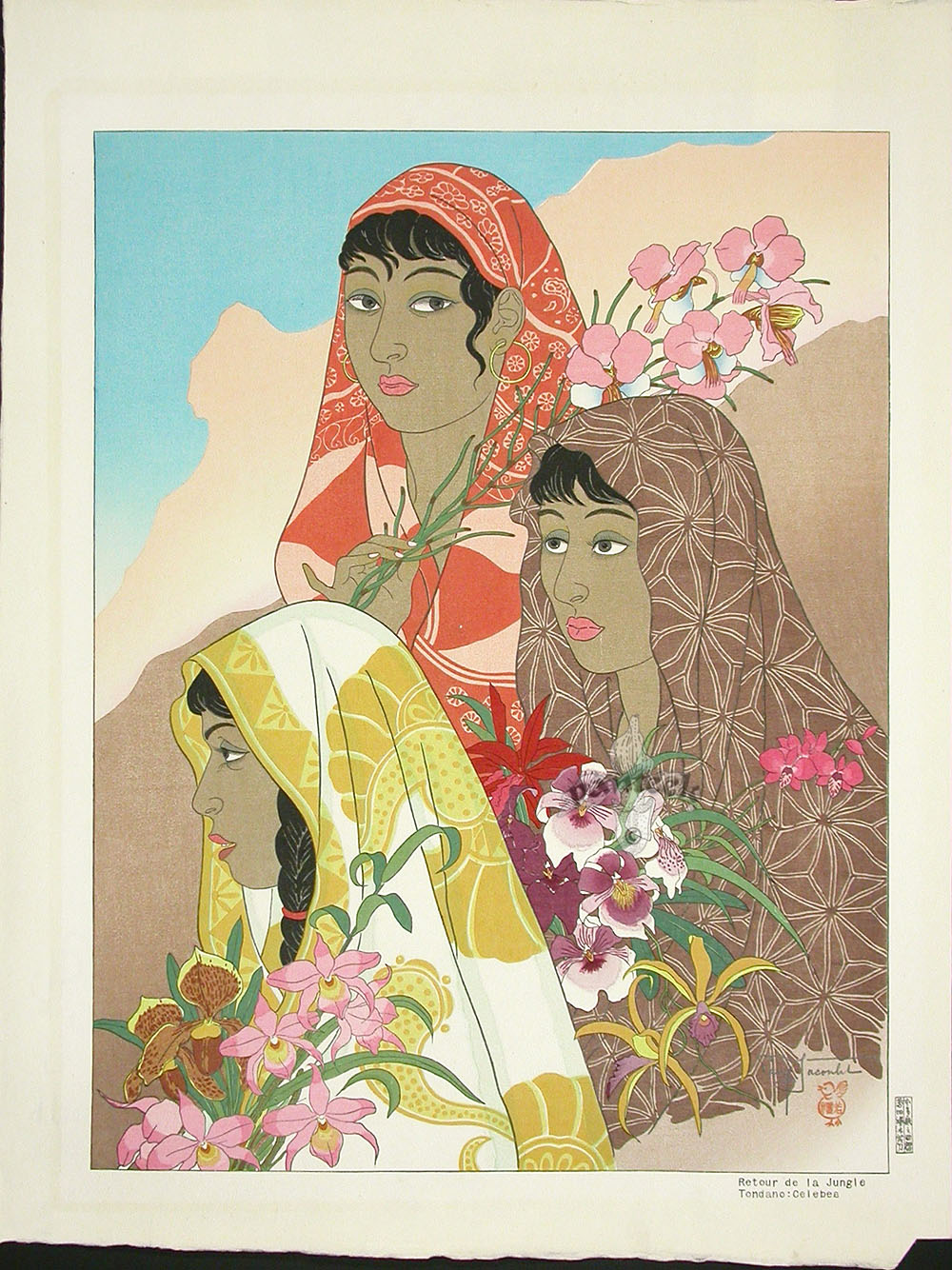|
While our images are electronically watermarked, the antique prints themselves are not.
Retour De La Jungle. Tondano, Celebes JCT12 $2795
Each print measures approximately 14
inches by 18 inches.
Signature: "Paul Jacoulet" in the plate.
Published: 28 January 1948
Carver: Maeda
Printer: Honda, Uchikawa
Seal: Sparrow
Condition: Fine
Paul
Jacoulet's art is a unique synthesis of the traditions
of the two great artistic cultures of Japan and France.
While born in Paris, his family moved to Japan
when he was six.
It was a time when Japan was still ruled by the
Imperial Court and the Emperor revered as a god.
Living in an elite neighborhood in Tokyo, he
attended fine Japanese private schools, becoming fluent
in Japanese, French and English.
At
an early age, he demonstrated artistic talent, and
studied under Seiki Kuroda, Takeji Fujishima and
Terukata Ikeda.
He embraced Japanese cultural skills and
traditions, including
gidayu (narrative chanting to the samisen)
and bijin-ga (paintings of beautiful women).
Surely his immersion in the Japanese culture in a
manner that few Westerners ever achieve was the platform
from which sprung his superb mastery of the art of
Japanese woodblock printing and his development of the
art to new heights.
Also
an accomplished linguist, he worked at the French
Embassy in Tokyo as a translator until the devastating
earthquake of 1923. As
biographer Richard Miles wrote, "Convinced he was not
spared to attend teas at the embassy and translate
unread memoranda; never again would Jacoulet stop
working at his art."ť
Paul's father returned to France to serve in the First
World War, but Paul's mother Jeanne and Paul remained in
Japan. After the
death of her husband, Jeanne remarried a Japanese
physician, Nakamura, and moved with her new husband to
the Japanese occupied city of Seoul, Korea. Paul
continued to work in Japan supported by his mother.
His
first trip to Micronesia occurred in 1928 due in some
part to his poor health and the quest for relief from
his chronic respiratory disorder.
These visits provide the inspiration for some of
his most beautiful works, in a style reminiscent of
another great painter inspired by the South Sea Islands,
Gauguin.
Jacoulet self published many of his prints and worked
with the most skilled woodblock carvers and printers of
the day. He
spared no expense in using the best quality materials,
papers and pigments, including silver and gold,
mica and other precious elements.
Thus, his prints have a unique beauty and have
survived the passage of time much better than many
woodblock prints due to the quality of materials used.
His exacting standards caused many prints to be
destroyed and his lifetime output is generally thought
to be about 166 prints, though he made many thousands of
drawings and paintings.
Prior to the March 1945 Tokyo fire-bombing, Jacoulet's
works were moved from his studio in Akasaka to Karuizawa
and thus saved from the devastation that overtook Tokyo
and certain destruction.
In Karuizawa, a house was purchased for Paul and
the two Korean brothers he had adopted.
The house still
stands today, with over 2000 prints and paintings
intact, carefully preserved by his adopted son Tomita's
daughter, Therese, and supporters of his work after his
death.
In
2003 the first major Japanese exhibit of his work "The
Rainbow Vision of French Ukiyo-e Artist Paul Jacoulet"
opened at the Yokohama Museum of Art, linked here.
http://search.japantimes.co.jp/cgi-bin/fa20030521a1.html
His
art became a great favourite with the American
occupation troops, including General MacArthur who
arranged for him to work at the Tokyo Army College,a center of educational
and cultural activities for members of the occupational
forces and Japanese citizens alike.
Many
illustrious people and museums collected his work
including General MacArthur, Queen Elizabeth II, Greta
Garbo, Pope Pius X1, President Truman, the British
Museum and the Asia Pacific Museum. Today, it is widely revered, hard to find, as the
editions were relatively small, and highly prized and
collected.
Each
print measures approximately 14 inches by 18 inches. The
high quality paper is in excellent condition, with very
little of the toning so often seen and the rich, vibrant
colouring so typical of his work.
The
notch cut in the corner of the paper represents a
registration cut for aligning the paper during printing.
The verso contains either the print's edition number
stamp or the elaborate PJ stamp.
We
accept credit cards & PayPal. Washington state residents
pay Washington state sales tax. Shipping for this
item is $20. Items can be combined to save on
postage. Our environment is smoke free. We pack
professionally using only new materials. All items are
beautifully wrapped and suitable for sending directly as
gifts. You may return any item within 7 days if not
satisfied. To order, you may call us at 1-888-PANTEEK,
fax or email.

  
|

